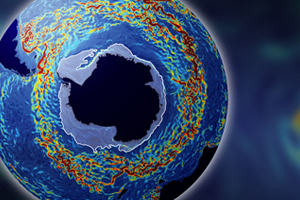Antarctic Eddies: SA Agulhas II out to sea
30 April 2014
With huge daily operating costs, polar research vessel the SA Agulhas II doesn't often put to sea. So it was a high-five moment when Kirrin Reid heard that her honours research would be a dedicated focus during the ship's annual relief voyage to the subantarctic Prince Edward Islands. This research investigates the warm eddies affecting the frontal polar ice.
It's a blustery autumn day at the Cape Town docks and on the east pier the SA Agulhas II is being loaded, a riot of gulls above.
Six women attached to UCT's Department of Oceanography have just boarded their home for the next 36 days. They'll be supporting master's student Kirrin Reid, whose honours project (completed last year) will underpin the scientific part of the voyage.
Also on board is a Department of Environmental Affairs' (DEA) Oceans and Coasts division team.
Project leader and senior lecturer Dr Isabelle Ansorge is leading the all-woman UCT group and is something of a veteran of these research voyages, both on the old and the new ships.
In the subantarctic zone of the Indian Ocean, they'll be observing southward-propagating eddies that bring warm, salty water to the polar frontal band of ice circling the Antarctic.
These circular currents flow across the Antarctic Circumpolar Current that surrounds Antarctica, and into the Antarctic zone.
Warm water going south
Reid observed these currents during her honours research by studying satellite images. She found that only warm eddies move southwards, propagating along distances of 750km in 12 months.
Further investigation showed that the narrowest band of winter sea ice formation (between 20 and 30°E) could be attributed to this corridor of warm eddies. But Reid was unable to resolve the full scope of their physical and biological structure during her honours project.
Reid needed to conduct observations at sea. Now, on board the SA Agulhas II, she'll be able to do this, supported by four other postgraduate researchers attached to UCT's oceanography department: Katherine Hutchinson, Moagabo Ragoasha, Lisa Holton from the UK, and Alice Lebehot from France.
They'll start by studying two ocean eddies: a recently formed eddy in the subantarctic (at 49°S, 30°E), and one that has relocated southwards into the Antarctic zone (to approximately 58°S).
Importance of eddies
"Until the late 1960s, oceanographers thought ocean circulation consisted only of slowly moving interior gyres and fast-flowing boundary currents," Ansorge explains. "However, the oceans contain thousands of vigorous eddies at spatial scales ranging from 50 to 150 nautical miles, which evolve over time scales that range from weeks to months."
Drifting slowly, these eddies rotate and carry either warm or cold water masses - and their associated biota (the plant and animal life of the region) - between the ocean basins. (A DEA biological team, led by Dr Hans Verheye, will deploy net tows to depths of 2 000m to examine the biota within each eddy.)
"Eddies are one of the most dominant sources of flow variability in the world's ocean and they're linked to areas of prominent topographic features, such as underwater mountain ridges," Ansorge says.
"They form isolated 'hotspots' of intense biological and physical activity and present one of the main mechanisms in which water characteristics such as heat, salt, carbon dioxide, nutrients and biota are exchanged around the oceans."
As such, they're a vital component in balancing Earth's ocean climate.But understanding their complex behaviour remains one of the grand challenges for oceanographers and climate scientists, says Ansorge.
Biological stations
Reid and her co-researchers will conduct their research via oceanographic and biological stations at 10 nautical mile intervals. The team will work 12-hour shifts, operating the oceanographic instruments and analysing the data.
A CTD (conductivity, temperature, depth) instrument is the main workhorse, measuring temperature, salinity and other hydrographic variables in the water column at depths up to 5 000m. Samples for nutrients such as nitrates, phosphates and silicates, and carbon dioxide will be collected manually from bottles attached to the CTD.
A suite of robotic data-gathering instruments will continue to record and relay high-resolution oceanographic data back to the scientists after the survey ends.
While Reid's data will provide information on the exchange of heat and salt fluxes along this subantarctic eddy corridor, water samples will also provide invaluable insight into the adaptability of plankton over time as eddies relocate southward, introducing waters typical of the subantarctic into the Antarctic zone.
Class afloat
As the trip is a module of the Oceanography-taught MSc class, the postgraduate students will attend lectures and tutorials in the dedicated lecture theatre - and collect data for mini projects related to the survey.
The all-woman team reflects a discernable, growing trend in a previously male-dominated field as more women are drawn to physical oceanography, says Ansorge.
And for postgraduate students like Lisa Holton from the UK, this expedition offers new insights and experience - it's her first trip into Southern Hemisphere waters on a ship like the SA Agulhas II, arguably the world's leading research vessel.
Story Helen Swingler.
Read more:
Co-badged degree offers oceanographer a French connection
 This work is licensed under a Creative Commons Attribution-NoDerivatives 4.0 International License.
This work is licensed under a Creative Commons Attribution-NoDerivatives 4.0 International License.
Please view the republishing articles page for more information.
News
Front page
Previous Editions










